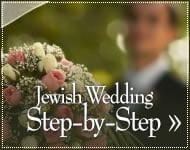ב"ה
Celebrating the Jewish Marriage Covenant
|
Before the wedding, two ceremonies occur: Kabbalat Panim, where the groom is honored at a table with guests, and Hakhnassat Kallah, which celebrates and honors the bride.
|
|
An in-Depth Look at the Jewish Marriage Contract
The ketubah is a legal document in Aramaic outlining a husband's obligations to his wife, ensuring her rights and protection in marriage and divorce situations.
|
|
The veiling ceremony (bedeken), held only for a bride's first marriage, symbolizes modesty, dignity, and a new identity. The groom veils the bride, marking their union.
|
|
A Jewish wedding has two main ceremonies: betrothal (kiddushin) with blessings and a ring, followed by nuptials (nissuin) with seven blessings, breaking of the glass and yichud (seclusion).
|
|
The chuppah, a tapestry on four poles, symbolizes the couple's home and marriage's legal conclusion.
|
|
The wedding procession's order and decor vary based on custom. The groom arrives first, symbolizing his home, while family escorts provide support.
|
|
Candles in the bridal procession symbolize joy and the covenant of marriage, echoing the light associated with celebrations and the divine covenant at Sinai.
|
|
Traditionally, the bride circles the groom three or seven times under the chuppah, symbolizing protection, unity, and the establishment of their new family circle.
|
|
At the chuppah, all typically stand to honor the couple. The bride stands to the groom's right, and they tipically face east.
|
|
At Jewish weddings, two blessings over wine are recited using separate cups for betrothal and nuptials, symbolizing sanctity and separation, akin to the Shabbat.
|
|
After the initial wine blessing, the rabbi recites the betrothal blessing, acknowledging the sanctity of marriage.
|
|
Before placing the ring, the groom recites a proposal in Hebrew, declaring the bride's exclusivity and the marriage's sanctity per Jewish law.
|
|
The marriage ring symbolizes betrothal in Jewish tradition, with specific laws about its use, ownership, and presentation, emphasizing its sanctity and the exclusivity of the union.
|
|
The reading of the Aramaic marriage contract, or ketubah, is a significant tradition separating betrothal from nuptials.
|
|
The seven blessings under the chuppah are recited in the presence of a minyan, celebrating creation, marriage, joy, and community. They honor the couple and Jewish survival.
|
|
The glass breaking at Jewish weddings symbolizes joy tempered with sorrow, recalling the Temple's destruction while celebrating the couple's new life together.
|
|
The final step of the marriage ceremony involves the brid and groom spending private time together.
|
|
The first meal after a wedding includes the seven blessings, symbolizing joy and remembrance of the Temple's destruction. Wine ceremonies celebrate their union.
|
|
For seven days following the wedding, Grace After Meals is followed by seven blessings, recited over cup of wine.
|
|
Jewish law mandates couples stay together for the first week post-wedding, celebrating with family and friends, to deepen their bond and adjust to married life.
|
|
The Bible emphasizes a year of adjustment for newlyweds to foster love and stability, ensuring strong family foundations crucial for community survival.
|





